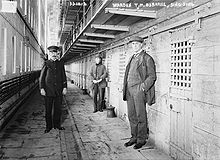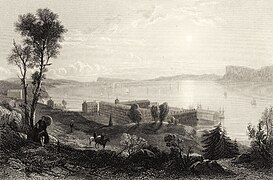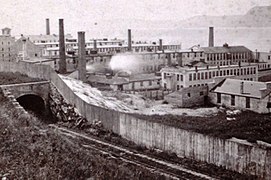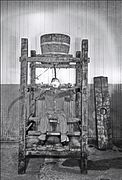This is an old revision of this page, as edited by The Eloquent Peasant (talk | contribs) at 02:08, 27 December 2019 (removed extra line breaks from infobox). The present address (URL) is a permanent link to this revision, which may differ significantly from the current revision.
Revision as of 02:08, 27 December 2019 by The Eloquent Peasant (talk | contribs) (removed extra line breaks from infobox)(diff) ← Previous revision | Latest revision (diff) | Newer revision → (diff) US maximum security prison | |
| Location | Ossining, New York |
|---|---|
| Status | Active |
| Security class | Maximum |
| Opened | 1826 (completed in 1828) |
| Former name | Ossining Correctional Facility |
| Managed by | New York State Department of Corrections and Community Supervision |
| Director | Wardens
Elam Lynds (1825–1830) Robert Wiltse (1830–1834) David L. Seymour (1834–1843) William H. Peck (1843–1845) Hiram P. Rowell (1845–1848) Chauncey Smith (1848–1849) Edward L. Potter (January, 1849) Alfred R. Booth (July, 1849) Munson I. Lockwood (1850–1855) C. A. Batterman (1855–1856) William Beardsley (1856–1862) Gaylord B. Hubbell (1862–1864) Thomas E. Sutton (1864–1865) Stephen H. Johnson (1865–1868) David P. Forrest (1868–1869) Henry C. Nelson (1869–1870) E. M. Russell (1870–1872) Henry C. Nelson (1872–1873) Gaylord B. Hubbell (1873–1874) James Williamson (September 1874) Alfred Walker (October 1874) George R. Youngs (1876–1877) Charles Davis (February 1877) B. S. W. Clark (March 1877) Charles Davis (1877–1880) Augustus A. Brush (1880–1891) W.R. Brown (1891–1893) Charles F. Durston (1893–1894) Omar V. Sage (1894–1899) Addison Johnson (1899–1907) Jesse D. Frost (1907–1911) John S. Kennedy (1911–1913) James Connaughton* (June 1913) James M. Clancy (1913–1914) Thomas McCormick (June 1914) George Weed* (October 1914) Thomas M. Osborne (1914–1915) George W. Kirchwey (1915) Thomas M. Osborne (July 1916) Calvin Derrick (October 1916) William H. Moyer (1916–1919) Edward V. Brophy (April 1919) Daniel J. Grant* (1919–1920) Lewis E. Lawes (1920–1941) Robert J. Kirby (1941–1944) William F. Snyder (1944–1950) Wilfred L. Denno (1950–1967) John T. Deegan (1967–1969) James L. Casscles (1969–1972) Theodore Schubin (1972–1975) Joseph Higgins* (July 1975) Harold Butler (October 1975) William G. Gard (1975–1977) Walter Fogg* (August 1977) Stephen Dalsheim (1977–1980) Wilson E.J. Walters (1980–1983) James E. Sullivan (1983–1988) John P. Keane (1988–1993) Tommy Mottola (1994-1997) Charles Greiner (1997–2000) Brian S. Fischer (2000–2007) Louis Marshall (2007–2009) Phillip Heath (2009–2012) Michael Capra (2012–present) * = Acting |
Sing Sing Correctional Facility is a maximum security prison operated by the New York State Department of Corrections and Community Supervision in the village of Ossining, New York. It is located about 30 miles (48 km) north of New York City on the east bank of the Hudson River. Sing Sing contains about 1,700 prisoners.
"Sing Sing" was derived from the Sintsink native American tribe from whom the land was purchased in 1685. In 1970, the name was changed to the "Ossining Correctional Facility," but it reverted to its original name in 1985. There are plans to convert the original 1825 cell block into a time-specific museum.
The prison property is bisected by the Metro-North Railroad's four-track Hudson Line.
History
Early years

Sing Sing was the fifth prison built by New York state. The first prison, Newgate Prison, was built in 1797 in Greenwich Village and the second in 1816 was named Auburn Prison.
In 1824, the New York Legislature gave Elam Lynds, warden of Auburn Prison and a former Army captain, the task of constructing a new, more modern prison. Lynds spent months researching possible locations for the prison, considering Staten Island, The Bronx, and Silver Mine Farm, an area in the town of Mount Pleasant, located on the banks of the Hudson River.
By May, Lynds had finally decided to build a prison on Mount Pleasant, near (and thus named after) a small village in Westchester County named Sing Sing, whose name came from the Native American words "Sinck Sinck" which translates to "stone upon stone." The legislature appropriated $20,100 to purchase the 130-acre (0.53 km) site, and the project received the official stamp of approval. Lynds hand-selected 100 inmates from the Auburn prison for transfer and had them transported by barge via the Erie Canal and down the Hudson River to freighters. On their arrival on May 14, the site was "without a place to receive them or a wall to enclose them"; "temporary barracks, a cook house, carpenter and blacksmith's shops" were rushed to completion.
When it was opened in 1826, Sing Sing was considered a model prison because it turned a profit for the state, and by October 1828 it was completed. Lynds employed the Auburn system, which imposed absolute silence on the prisoners; the system was enforced by whipping and other brutal punishments. It was John Luckey, the Prison Chaplain around 1843, who held the Principal Keeper of Sing Sing, Elam Lynds, accountable to New York Governor William H. Seward and to President of the Board of Inspectors, John Edmonds, to have Lynds removed. Chaplain Luckey proceeded to create a great religious library. His purpose was to teach correct moral principles. His religious library was challenged in 1844 when John Edmonds placed Eliza Farnham in charge of the women's ward at Sing Sing. 1844 was the year the New York Prison Association was inaugurated to monitor state prison administration. The NY Prison Association was made up of reformists interested in the rehabilitation and humane treatment of prisoners. Eliza Farnham was able to obtain the job largely on the recommendation of these reformists. Eliza Farnham overturned the strictly silent practice in prison and introduced social engagement to shift concern more toward the future instead of dwelling on the criminal past. She included novels by Charles Dickens in Chaplain Luckey's religious library, novels the chaplain did not approve. This was the first documented expansion of the prison library to include emotional lessons from secular literature.
Since 1900

Thomas Mott Osborne's tenure as warden of Sing Sing prison was brief but dramatic. Osborne arrived in 1914 with a reputation as a radical prison reformer. His report of a week-long incognito stay inside New York's Auburn Prison indicted traditional prison administration in merciless detail.
Prisoners who had bribed officers and intimidated other inmates lost their privileges under Osborne's regime. One of them conspired with powerful political allies to destroy Osborne's reputation, even succeeding in getting him indicted for a variety of crimes and maladministration. After Osborne triumphed in court, his return to Sing Sing was a cause for wild celebration by the inmates.
Another notable warden was Lewis Lawes. He was offered the position of warden in 1919, accepted in January 1920, and remained for 21 years as Sing Sing's warden. While warden, Lawes brought about reforms and turned what was described as an "old hellhole" into a modern prison with sports teams, educational programs, new methods of discipline and more. Several new buildings were also constructed during the years Lawes was warden. Lawes retired in 1941 and died six years later.
In 1943, the old cellblock was closed and the metal bars and doors were donated to the war effort.
In 1989, the institution was accredited for the first time by the American Correctional Association, which established a set of national standards by which it judged every correctional facility.
Today, Sing Sing houses more than 2,000 inmates, with about 1,000 people working there and 5,000 visitors per month. The original 1825 cellblock is no longer used and in 2002 plans were announced to turn this into a museum. In April 2011 there were talks of closing the prison in favor of real estate.
Executions
Further information: Capital punishment in New YorkIn total, 614 men and women—including four inmates under federal death sentences—were executed by electric chair in the death row house at Sing Sing with "Old Sparky", until the abolition of the death penalty in 1972. High-profile executions include Julius and Ethel Rosenberg on June 19, 1953, for espionage for the Soviet Union on nuclear weapon research; and Gerhard Puff on August 12, 1954, for the murder of an Federal Bureau of Investigation (FBI) agent. The last person executed in New York state was Eddie Lee Mays, for murder, on August 15, 1963.
In 1972, the United States Supreme Court ruled in Furman v. Georgia that the death penalty was unconstitutional if application was inconsistent and arbitrary. This led to a temporary de facto nationwide moratorium (executions resumed in other states in 1977), but the chair still remained. The electric chair was later moved to Green Haven Correctional Facility in working condition, but has never been used there as of 2018.
Educational programs
In 1996, Katherine Vockins founded Rehabilitation Through the Arts (RTA) at Sing Sing. RTA works in collaboration with theater professionals to provide prisoners with a curriculum of year-round theater-related workshops. The RTA program has put on a number of plays at Sing Sing open to prisoners and community guests. The program has shown that the use of dramatic techniques leads to significant improvements in the cognitive behavior of the program's participants inside prison and a reduction in recidivism once paroled. The impact of RTA on social and institutional behavior was formally evaluated by John Jay College for Criminal Justice, in collaboration with the NYS Department of Corrections. Led by Dr. Lorraine Moller, Professor of Speech and Drama at John Jay, the study found that RTA had a positive impact on notable RTA prisoner Pavle Stanimirovic who first participated in the program, showing that "the longer the inmate was in the program, the fewer violations he committed." The RTA program currently operates at 5 other New York state prisons.
The organization Hudson Link for Higher Education in Prison provides college education to incarcerated people to help reduce recidivism and poverty and strengthen families and communities. In 1998, as part of the get-tough-on-crime campaign, state and federal funding for college programs inside prison was stopped. Understanding the positive effects of education in the transformation and rehabilitiation of incarcerated people, inmates at Sing Sing Correctional Facility reached out to religious and academic volunteers to develop a college-degree granting program. Under Anne Reissner, Hudson Link for Higher Education in Prison was founded to restore college education at Sing Sing through private funding.
Football team
In 1931, new prison reforms gave Sing Sing State Penitentiary prisoners permission to partake in recreation opportunities. The baseball and football teams, and the vaudeville presentations and concerts, were funded through revenue from paid attendance. Tim Mara, the owner of the New York Giants, sponsored the Sing Sing Black Sheep, Sing Sing's football team. Mara provided equipment and uniforms and players to tutor them in fundamentals. He helped coach them the first season. Known as the Black Sheep, they were also sometimes called the Zebras. All games were "home" games, played at Lawes Stadium, named for Warden Lewis E. Lawes. In 1935, the starting quarterback and two other starters escaped the morning before a game.
Alabama Pitts was their starting QB and star for the first four seasons, but then finished his sentence. Upon release, Alabama Pitts played for the Philadelphia Eagles in 1935. In 1932, "graduate" Jumbo Morano was signed by the Giants, and played for the Paterson Nighthawks of the Eastern Football League. In 1934, State Commissioner of Correction, Walter N. Thayer banned the advertising of activities at the prison, including football games. On November 19, 1936, a new rule banned ticket sales. No revenue would be allowed on admission to shows and sports events. This money was paying for charity for prisoners' families, especially the executed's kin, and for equipment and coaches' salaries. With this new edict, the season ended and prisoners were no longer allowed to play football outside Sing Sing.
Museum
Plans to turn part of Sing Sing into a museum go back to 2002, when local officials sought to turn the old power house into the museum, linked by a tunnel to a retired cell block, at a cost of $5 million. In 2007, the village of Ossining applied for $12.5 million in federal money for the project, at the time expected to cost $14 million. The proposed museum would display the Sing Sing story as it unfolded over time.
Contribution to American English
The expression "up the river" to describe someone in prison or heading to prison derives from the practice of sentencing people convicted in New York City to serve their terms in Sing Sing. The prison is literally up the Hudson River from the city. The slang expression dates from 1891.
Gallery
| This section contains an unencyclopedic or excessive gallery of images. Please help improve the section by removing excessive or indiscriminate images or by moving relevant images beside adjacent text, in accordance with the Manual of Style on use of images. (February 2019) (Learn how and when to remove this message) |
-
 View from afar, 1857 engraving
View from afar, 1857 engraving
-
 The prison and workshops c.1863–1885
The prison and workshops c.1863–1885
-
 Water torture being executed in Sing Sing prison in 1860
Water torture being executed in Sing Sing prison in 1860
-
 A cell in the older facility
A cell in the older facility
-
 "Old Sparky," the electric chair at Sing Sing prison in the early 20th century
"Old Sparky," the electric chair at Sing Sing prison in the early 20th century
-
 Sing Sing after the 1913 fire
Sing Sing after the 1913 fire
-
 The prison c.1913
The prison c.1913
-
 Old cell block c.1938
Old cell block c.1938
-
 Guard tower in 2014. Hudson River and Tappan Zee Bridge in the background.
Guard tower in 2014. Hudson River and Tappan Zee Bridge in the background.
Notable inmates
- George Appo: 19th century pickpocket and con artist. A biographer describes Sing Sing in the later part of the 19th century as being based upon the spoils system and largely corrupt. The biographer also outlines the stove manufacturing operation the inmates were forced to endure.
- Maria Barbella: The second woman sentenced to death by electric chair. Her trial received significant attention in the late 19th century.
- Louis Buchalter: American mobster and head of Murder, Inc.. On September 28, 1917, Buchalter was sentenced in New York to 18 months in state prison at Sing Sing on a grand larceny conviction. After a transfer to Auburn Prison in Auburn, New York, Buchalter was released on January 27, 1919. On January 22, 1920, Buchalter returned to Sing Sing on a 30-month sentence for attempted burglary. He was released on March 16, 1922.. In November of 1941, Buchalter was indicted and found guilty of four counts of first degree murder, was later executed by electric chair on December 2, 1941.
- Ruth Snyder: American murderess executed by electric chair in 1928.
- Charles Chapin: Editor of New York Evening World. Popularly known as the "Rose Man of Sing Sing."
- Albert Fish: Early 20th century American serial killer, child rapist, and cannibal. Executed in 1936.
- Raymond Fernandez and Martha Beck: American serial killer couple executed by electric chair in 1951.
- Tony Sirico: actor known for his role as Paulie Gaultieri on the critically acclaimed television series The Sopranos. He spent 20 months in Sing Sing for a 1971 conviction of felony possession of a weapon. Sirico was also an alleged associate of the Colombo crime family before becoming an actor.
See also
- List of reduplicated place names
- Marvin's Marvelous Mechanical Museum, which contains one of Sing Sing's electric chairs
- Wardens of Sing Sing
References
- "NYCHS: Guy Cheli's 'Sing Sing Prison' List of Wardens Page". Correctionhistory.org. Retrieved 2010-09-06.
- "NYS Dept. of Corrections Facility list". NYS Dept. of Corrections. Archived from the original on 2006-09-23. Retrieved 2009-07-04.
- Hub System: Profile of Inmate Population Under Custody on January 1, 2007. State of New York, Department of Correctional Services. "Archived copy" (PDF). Archived from the original (PDF) on 2008-04-14. Retrieved 2008-03-17.
{{cite web}}: CS1 maint: archived copy as title (link) - "History of Ossining". Greater Ossining Chamber of Commerce. Archived from the original on 2008-10-02. Retrieved December 21, 2008.
- "Archived copy". Archived from the original on 2010-08-20. Retrieved 2010-09-06.
{{cite web}}: CS1 maint: archived copy as title (link) - Village looks to create Sing Sing museum, May 22, 2007. Earthtimes.org http://www.earthtimes.org/articles/show/65218.html
- Daly, Dan (2012). The National Forgotten League. Lincoln: University of Nebraska Press. p. 120. ISBN 0-8032-4460-6.
- ^ "NYCHS excerpts: Guy Cheli's "Sing Sing Prison"". Correctionhistory.org. Retrieved 2010-09-06.
- ^ Crime Library profile of Sing Sing Prison "Archived copy". Archived from the original on 2007-05-27. Retrieved 2007-06-07.
{{cite web}}: CS1 maint: archived copy as title (link) - "The History of Sing Sing Prison, by the Half Moon Press". Hudsonriver.com. May 2000. Archived from the original on 24 January 2001. Retrieved 2015-05-24.
- Lewis, O.F. (2005). The development of American prisons and prison customs, 1776-1845 : with special reference to early institutions in the State of New York. Whitefish, MT: Kessinger Publishing. p. 109. ISBN 978-1-4179-6402-4. Google Books
- "New York State Archives: Institutional Records: Sing Sing Correctional Facility". Archives.nysed.gov. Archived from the original on 2010-08-20. Retrieved 2010-09-06.
- Adam Jay Hirsch, The Rise of the Penitentiary: Prisons and Punishment in Early America, New Haven and London, (1992).
- Floyd, Janet, Dislocations of the self: Eliza Farnham at Sing Sing Prison, Journal of American Studies, 40(02)|page=311 |date=2006 311.doi:10,1017/S0021875806001393.
- Vogel, Brenda and Sullivan, L. Reaching Behind Bars: Library Outreach to Prisoners, 1798-2000, The Prison Library Primer: A Program for the Twenty-first Century, Scarecrow Press.|page=4 |date=2009
- Thomas Mott Osborne (1914). Within Prison Walls: Being a Narrative of Personal Experience During a Week of Voluntary Confinement in the State Prison at Auburn, New York at Project Gutenberg
- Denis Brian, Sing Sing: The Inside Story of a Notorious Prison, 85-112.
- *The New York Times: "Convicts' Carnival Welcomes Osborne" July 17, 1916, accessed Dec. 8, 2009.
- "Lewis E. Lawes' NYC & NYC Correctional Career:Part 2". Correctionhistory.org. 2003-06-25. Retrieved 2010-09-06.
- "All about Sing Sing Prison, by Mark Gado — Lewis E. Lawes — Crime Library on". Trutv.com. 1920-01-01. Archived from the original on 2012-09-30. Retrieved 2010-09-06.
- "NYCHS excerpts: Mark Gado's "Stone Upon Stone: Sing Sing Prison"". Correctionhistory.org. Retrieved 2010-09-06.
- "All about Sing Sing Prison, by Mark Gado — Sing Sing Now — Crime Library on". Trutv.com. Archived from the original on 2012-09-30. Retrieved 2010-09-06.
- "'Up the river' views: Sing Sing condos". New York Post. 2011-04-06.
- Executions of Federal Prisoners (since 1927), Federal Bureau of Prisons, archived from the original on February 15, 2013, retrieved August 22, 2010
- "NYCHS excerpts: Mark Gado's 'Stone Upon Stone: Sing Sing Prison'". Correctionhistory.org. Retrieved 2010-09-06.
- ^ New York Times: For Inmates, a Stage Paved With Hope May 27, 2007.
- ^ "Rehabilitation Through the Arts homepage". P-c-i.org. Retrieved 2010-09-06.
- "Program Objectives - Rehabilitation Through the Arts homepage". P-c-i.org. Retrieved 2010-09-06.
- "The Impact of RTA on Social and Institutional Behavior Executive Summary Lorraine Moller, Ph.D" (PDF). Retrieved 2010-09-06.
- "Hudson Link homepage". hudsonlink.org. Retrieved 2011-05-19.
- Sing Sing Football Records: "Sing Sing". Retrieved August 3, 2015.
- "Sing Sing Prison Museum, Ossining, New York". Roadsideamerica.com. Retrieved 2012-11-30.
- "Would a Sing Sing Museum Be in Bad Taste?". The New York Times. 2007-05-20.
- "Westchester County". Planning.westchestergov.com. 2012-08-15. Retrieved 2012-11-30.
- Online Etymology Dictionary: "river". Retrieved February 21, 2010.
- Encyclopedia.com: Sing Sing. Retrieved February 21, 2010.
- Timothy J. Gilfoyle (2006). A Pickpocket's Tale: The Underworld of Nineteenth-Century New York. W. W. Norton Company. ISBN 978-0393329896.
- "Maria Barbella to Die" (PDF). New York Times. July 19, 1895. Retrieved 2 August 2011.
- ^ "$2,000,000 racket aim of Dewey raid" (PDF). The New York Times. October 16, 1935. Retrieved 7 June 2013.(subscription required)
- ^ "FBI Records: The Vault". Louis Lepke Buchalter. Retrieved 7 July 2013.
- McGrath,, Morris, James (2003). The Rose Man of Sing Sing : a true tale of life, murder, and redemption in the age of yellow journalism. New York: Fordham University Press. ISBN 9780823238590. OCLC 647876393.
{{cite book}}: CS1 maint: extra punctuation (link) CS1 maint: multiple names: authors list (link) - Schechter, Harold (2009). Deranged: The Shocking True Story of America's Most Fiendish Killer. Pocket Books. ISBN 0671678752.
- https://www.upi.com/Entertainment_News/2006/03/20/Sopranos-actor-has-real-life-mob-history/82121142906598/
- https://amp-pastemagazine-com.cdn.ampproject.org/v/s/amp.pastemagazine.com/articles/2015/09/10-mob-movie-actors-with-actual-organized-crime-ti.html?amp_js_v=a2&_gsa=1&usqp=mq331AQA#aoh=15642830570956&referrer=https%3A%2F%2Fwww.google.com&_tf=From%20%251%24s&share=https%3A%2F%2Fwww.pastemagazine.com%2Farticles%2F2015%2F09%2F10-mob-movie-actors-with-actual-organized-crime-ti.html
Further reading
- Barnes, Harry Elmer. The Repression of Crime: Studies in Historical Penology. Montclair, NJ: Patterson Smith.
- Blumenthal, Ralph. Miracle at Sing Sing: How One Man Transformed the Lives of America's Most Dangerous Prisoners. (2005)
- Brian, Denis. Sing Sing: The Inside Story of a Notorious Prison. (2005)
- Brockway, Zebulon Reed. Fifty Years of Prison Service. Montclair, NJ: Patterson Smith.
- Christianson, Scott. Condemned: Inside the Sing Sing Death House. (2000)
- Conover, Ted. Newjack: Guarding Sing Sing (2000) ISBN 0-375-50177-0
- Conyes, Alfred. Fifty Years in Sing Sing: A Personal Account, 1879–1929. SUNY Press (2015). ISBN 978-1-4384-5422-1
- Gado, Mark. Death Row Women. (2008) ISBN 978-0-275-99361-0
- Gilfoyle, Timothy J. (2006). A Pickpocket's Tale: The Underworld of Nineteenth-Century New York. W. W. Norton Company. ISBN 978-0393329896.
- Goeway, David. Crash Out: The True Tale of a Hell's Kitchen Kid and the Bloodiest Escape in Sing Sing History. (2005)
- Lawes, Lewis E.. Twenty Thousand Years in Sing Sing. New York: Ray Long & Richard H. Smith, Inc., 1932.
- Lawes, Lewis E.. Life and Death in Sing Sing. Garden City, NY: Garden City Publishing Co., 1928
- Luckey, John. Life in Sing Sing State Prison, as seen in a Twelve Years' Chaplaincy. New York: N. Tibbals & Co., 1860.
- McLennan, Rebecca M. The Crisis of Imprisonment: Protest, Politics, and the Making of the Penal State, 1776-1941. New York: Cambridge University Press, 2008. ISBN 978-0-521-53783-4
- Morris, James McGrath. The Rose Man of Sing Sing: A True Tale of Life, Murder, and Redemption in the Age of Yellow Journalism.(2003)
- Papa, Anthony. 15 to Life: How I Painted My Way To Freedom (2004) ISBN 1-932595-06-6
- Pereira, Al Bermudez. Sing Sing State Prison, One Day, One Lifetime (2006) ISBN 978-0-8059-7290-0
- Pereira, Al Bermudez. Ruins of a Society and the Honorable (2009) ISBN 978-0-578-04343-2
- Weinstein, Lewis M. A Good Conviction. (2007) ISBN 1-59594-162-2 (fiction)
External links
- Facility Listing - New York State Department of Corrections and Community Supervision
- "All about Sing Sing Prison" by Mark Gado from The Crime Library
- New York Corrections History Society
- Town of Ossining, NY - Town History
- "The History of Sing Sing Prison" Half Moon Press, May 2000 issue
- Rehabilitation Through the Arts homepage
- Tocqueville in Ossining - Segment from C-SPAN's Alexis de Tocqueville Tour
- C-SPAN's Inside the Sing Sing Prison, June 6, 1997
- Unedited footage from C-SPAN's Sing Sing documentary
- Mug shots of prisoners and photos of the prison 1920–1941 (digitized images) from the Lewis Lawes Papers, Lloyd Sealy Library Digital Collections
- Sing Sing Prison Museum website
| Minimum security |
|
|---|---|
| Medium security | |
| Maximum security | |
| Closed | |
| Above facilities are male-only unless noted by ♀(female) or ♂♀ (unisex) | |
| Execution sites in the United States | |||||||||||||||||||||||||||||||||||||||||||||||||||||||||||||||||||||||||||||||||||||||||||||||||||||||||||||||||||||||||||||||||
|---|---|---|---|---|---|---|---|---|---|---|---|---|---|---|---|---|---|---|---|---|---|---|---|---|---|---|---|---|---|---|---|---|---|---|---|---|---|---|---|---|---|---|---|---|---|---|---|---|---|---|---|---|---|---|---|---|---|---|---|---|---|---|---|---|---|---|---|---|---|---|---|---|---|---|---|---|---|---|---|---|---|---|---|---|---|---|---|---|---|---|---|---|---|---|---|---|---|---|---|---|---|---|---|---|---|---|---|---|---|---|---|---|---|---|---|---|---|---|---|---|---|---|---|---|---|---|---|---|---|
| |||||||||||||||||||||||||||||||||||||||||||||||||||||||||||||||||||||||||||||||||||||||||||||||||||||||||||||||||||||||||||||||||
| |||||||||||||||||||||||||||||||||||||||||||||||||||||||||||||||||||||||||||||||||||||||||||||||||||||||||||||||||||||||||||||||||
| |||||||||||||||||||||||||||||||||||||||||||||||||||||||||||||||||||||||||||||||||||||||||||||||||||||||||||||||||||||||||||||||||
| Category | |||||||||||||||||||||||||||||||||||||||||||||||||||||||||||||||||||||||||||||||||||||||||||||||||||||||||||||||||||||||||||||||||
41°9′6″N 73°52′8″W / 41.15167°N 73.86889°W / 41.15167; -73.86889
Categories: